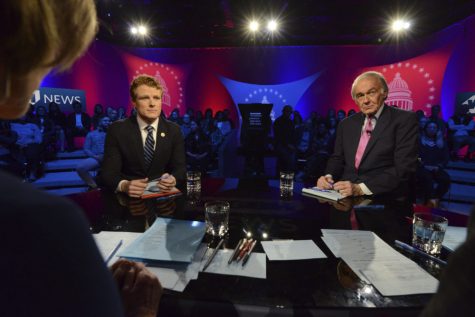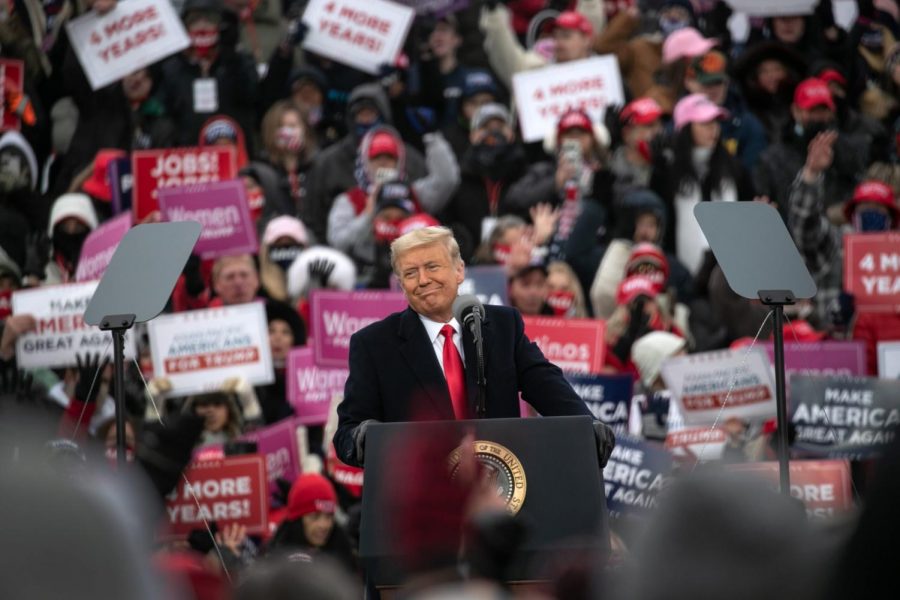Your donation will support the student journalists of Clayton High School. Your contribution will allow us to purchase equipment and cover our annual website hosting costs.
Election Strategy
January 24, 2021
U.S. President Donald Trump smiles while disparaging Democratic presidential nominee Joe Biden at a campaign rally at Oakland County International Airport on October 30, 2020 in Waterford, Michigan. With less than a week until Election Day, Trump and his opponent Joe Biden are campaigning across the country.
The COVID-19 pandemic has changed everything in our lives. From online learning to grocery shopping, nothing is the same. These effects were also felt heavily in the presidential election. COVID quickly moved to the top of many people’s voting criteria, and worries about the future of the economy have intensified. Additionally, millions of people voted by mail for the first time, testing the limits of our voting infrastructure. Both candidates adjusted their campaigns. Trump continued holding large in-person rallies, but had to leave the campaign trail for a few days while he was positive for coronavirus. Biden shifted to Zoom town halls, as well as small in-person events. Both candidates increased their digital capacity by sending out emails and phone calls to supporters, running ads and posting to social media.
In St. Louis, Cori Bush’s win in the democratic primary for the Missouri District 1 congressional seat provides an example of a successful socially-distanced campaign.
Another contested primary that took place over the summer was the Democratic primary for senator of Massachusetts. Incumbent Ed Markey beat challenger Joe Kennedy in what had originally been predicted to be an easy win for Kennedy.
Despite the changes the pandemic has brought to campaigning, many of the basic principles remain the same. When it comes to election strategy, there are two basic approaches: top-down or bottom-up. Top-down refers to a strategy in which a campaign tries to attract large donors and focuses on running TV ads. Bottom-up, also known as grassroots, emphasizes connecting with individual voters with the hope that they’ll tell their friends and family about your candidate.
[Grassroots] has been an important strategy, particularly for progressive ideas
— John Walsh
“Grassroots as a concept means starting with the voters and right from the ground and building that energy. [Grassroots] has been an important strategy, particularly for progressive ideas,” said John Walsh, campaign manager for Senator Ed Markey. “The most opposite of a grassroots campaign is top down. It’s very much dependent on money and television advertising. In other words you’re not taking in direct contact with people, but you are trying to distribute information to them using top down methods rather than bottom up.”
The rise of social media has allowed campaigns to connect with voters in new and unique ways. Apps like Twitter, Facebook and Instagram allow candidates to reach new audiences. Additionally, new technology has made it easier for campaigns to find who they should target with their ads.
“We’re both in an era of big data, where campaigns can go by national voter files. These are just records of whether people are turning out to vote or not. Those are paired up with commercially available data, maybe your credit score or what magazines you subscribe to. And then they use some psychometric and statistical models to try to figure out who to target… campaigns can potentially bolster turnout in ways that they couldn’t 10 years ago,” said Washington University political science professor Andrew Reeves.
Campaigns also evolve during their duration. In the beginning, campaigns must clarify their message and marketing. As the election nears, they must focus on reaching individual voters and making sure they will get out and vote.

In the case of Senator Markey’s campaign, initially, the polls showed Markey trailing behind Kennedy. Typically incumbents have a much higher chance of winning re-election. However, Markey’s case was different since Kennedy was so popular.
“I think his name recognition was high, his favorability was high, he had his job approval ratings high … As a matter of fact, by any standard measures you would say unbeatable based on those numbers, but we had an opponent who had equally strong numbers,” Walsh said.
Additionally, many people currently feel dissatisfied with the government which opens them up to voting for a challenger.
After creating a clear message for your campaign, the next step is focusing on voter engagement. Since many voters are too busy to focus on an election until right before, voter engagement efforts continue to ramp up as the election draws closer. The major way campaigns connect with voters is through the media.
“I believe any organization needs to become their own content generator. What that meant for us was to build an in house capacity to tell our story directly through digital, through social media and other direct voter methods. So we built a studio with analysis, audio, video and graphics capability, which included equipment space and professional staff,” Walsh said.
Because of the pandemic, digital content became crucial. Campaigns could no longer send volunteers to knock doors, so they were forced to reach voters digitally. Another important aspect of campaigning is fundraising. In order to create ads and other media posts, campaigns must have funding. A relatively new development in campaign funding is trying to reach out to small donors.
“One of the things that the Obama campaign did back in 2008 was to specifically decide to try to target those lower dollar donors. Before, it was $2000 [donors targeted]. Obama was one of the first candidates to really embrace this idea of getting the small dollar. The other part of it is once [a campaign] has your email address they can come back to you and ask you to do something else,” Reeves said.
In terms of the presidential campaign, two main factors affect strategy. First, the electoral college affects where presidential candidates allocate their resources.“In more recent times, especially with the Bush election in 2000, we see this hyper focus on 5, 6, 7 states where they’re the only ones that matter. Missouri used to be one of these states but now Missouri [always] goes Republican. No campaign resources will be expended here, the candidates won’t visit here and why should they?” Reeves said.
Another challenge for presidential candidates is shifting from a primary audience to a national audience. For Biden, in the primaries he was criticized for being too conservative. After winning the nomination, Biden has had to make it clear he will not advocate for the more progressive Democratic policies like the Green New Deal or defunding the police. Candidates must balance their more zealous base with a general audience.
Regardless of the results of the election, political strategy will continue to be important to our democracy. Walsh urges everyone to find a way to be politically involved in their community.
“I do think that’s a real risk for our democracy that more people don’t see a way to impact [politics] and then a smaller and smaller group of people start making decisions. I think there is an importance to engaging in politics. And for some people it may be doing this as work, or as a career, either being a candidate, being an activist, or just engaging as a volunteer,” Walsh said.
